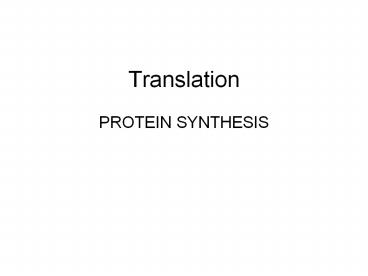Translation - PowerPoint PPT Presentation
1 / 16
Title:
Translation
Description:
Amino acids- the building blocks that are linked together to form the ... and a peptide bond is formed between this amino acid and the growing amino acid chain. – PowerPoint PPT presentation
Number of Views:41
Avg rating:3.0/5.0
Title: Translation
1
Translation
- PROTEIN SYNTHESIS
2
- Transcription Nucleic acid sequence (a gene) ?
an identical copy of the Nucleic acid sequence
(mRNA) - Translation Nucleic acid sequence (mRNA) ? a
sequence of Amino acids (a protein). - How do we decode the sequence of nucleotides on
mRNA and turn it into a sequence of amino acids
(a protein)?
3
- How many different amino acids are there?
- So can one base code for one amino acid ex. Can
adenosine (the base) code for tryprophan (an
amino acid)? - Can two bases?
- What about three?
4
- Meet tRNA the decoder
- There are 64 species of tRNA, each species
recognizes the code for an amino acid or a start
or stop signal - Why 64?
5
- Codons and Anticodons
- A codon is a group of three nucleotides on an
mRNA molecule - An Anticodon is the complimentary group of three
nucleotides on a tRNA - When the codon is recognized by the complimentary
anticodon on the tRNA the correct amino acid
corresponding to that codon is made available.
6
4 Components used in Translation
- mRNA- the message to be translated into protein.
- Amino acids- the building blocks that are linked
together to form the protein. - Ribosomes- the machines that carry out
translation.
7
- tRNA (transfer RNA)- brings an amino acid to the
mRNA and ribosome. - One end of a tRNA molecule has an anticodon that
complements with an mRNA codon. - The other end has a specific amino acid.
- A tRNA molecule with a particular anticodon
always carries the same type of amino acid.
8
How does translation occur?
- The ribosome binds to the mRNA molecule.
- The tRNA with the anticodon that complements the
first codon on the mRNA binds to the first site
on the ribosome. - Another tRNA with the anticodon that complements
the second codon on the mRNA binds to the second
site on the ribosome.
9
- A peptide bond forms between the first two amino
acids. - The first tRNA leaves, and the ribosome moves
along the mRNA to the next codon. - The next tRNA brings in the next amino acid, and
a peptide bond is formed between this amino acid
and the growing amino acid chain. - The process continues with the ribosome moving
along the mRNA molecule and the amino acids
linking together until a STOP codon is reached.
10
The CODE of translation
11
- mRNA nucleotides are translated in groups of 3
called codons. - AUGCACUGCAGUCGAUGA
12
- Each codon codes for a specific amino acid. 20
different amino acids can be used in different
combinations to form a protein. - For example
- mRNA codon amino acid
- AAU asparagine
- CGC arginine
- GGG glycine
13
Amino Acid sequence determines the 3-D protein
shape
- Interactions between amino acids cause folding
and bending of the chain - Examples
- positive () and negative (-) parts of amino
acids are attracted to each other. - hydrophobic regions are attracted to each other
- Folding
- http//www.stolaf.edu/people/giannini/flashanimat/
proteins/hydrophobic20force.swf - Structure levels
- http//www.stolaf.edu/people/giannini/flashanimat/
proteins/protein structure.swf
14
How is the amino acid sequence determined?
- The mRNA
- Each codon is a code for one amino acid
- DNA sequence T A C C G A G A T T
C A - mRNA sequence A U G G C U C U A A G U
- amino acid sequence Met -- Ala -- Leu --
Ser
15
U C A G
U UUU Phenylalanine (Phe) UCU Serine (Ser) UAU Tyrosine (Tyr) UGU Cysteine (Cys) U
U UUC Phe UCC Ser UAC Tyr UGC Cys C
U UUA Leucine (Leu) UCA Ser UAA STOP UGA STOP A
U UUG Leu UCG Ser UAG STOP UGG Tryptophan (Trp) G
C CUU Leucine (Leu) CCU Proline (Pro) CAU Histidine (His) CGU Arginine (Arg) U
C CUC Leu CCC Pro CAC His CGC Arg C
C CUA Leu CCA Pro CAA Glutamine (Gln) CGA Arg A
C CUG Leu CCG Pro CAG Gln CGG Arg G
A AUU Isoleucine (Ile) ACU Threonine (Thr) AAU Asparagine (Asn) AGU Serine (Ser) U
A AUC Ile ACC Thr AAC Asn AGC Ser C
A AUA Ile ACA Thr AAA Lysine (Lys) AGA Arginine (Arg) A
A AUG Methionine (Met) or START ACG Thr AAG Lys AGG Arg G
G GUU Valine Val GCU Alanine (Ala) GAU Aspartic acid (Asp) GGU Glycine (Gly) U
G GUC (Val) GCC Ala GAC Asp GGC Gly C
G GUA Val GCA Ala GAA Glutamic acid (Glu) GGA Gly A
G GUG Val GCG Ala GAG Glu GGG Gly G
16
Your turn
- Decoder construction-DNA Bingo
- Translation exercise (Find the secret message)
- Genes to proteins-practice worksheet.
- or
- Complete the Translation Practice worksheet































